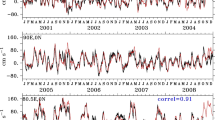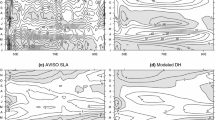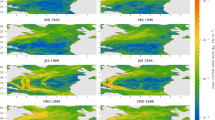Abstract
Spectra from two decades of zonal current data at \(\sim \) 4000 m in the central and western equatorial Indian Ocean show a shift in the dominant frequencies from the west to the east. The 120–180-day period is stronger at 77\(^\circ \) E, the 60–120-day period at 83\(^\circ \) E, and the 30–90-day period at 93\(^\circ \) E. The weakening of lower frequencies near the eastern boundary can be explained using theoretical ray paths of Kelvin waves and reflected Rossby waves. The equatorial Kelvin wave forced by winds reflects from the eastern boundary as Rossby waves with different meridional modes. After reflection, the low (high) frequency Rossby beams travel a larger (shorter) distance before reaching the bottom, thereby creating a shadow zone, a region with low wave energy, between the ray path and the eastern boundary. The shift in frequency with longitude is not evident in the top 1000 m, where the current is dominated by the semi-annual cycle.





Similar content being viewed by others
Data availability
The ocean current data are available from https://incois.gov.in/essdp/. The wind data were obtained from https://coastwatch.pfeg.noaa.gov/. The temperature and salinity data are from https://www.ncei.noaa.gov/products/world-ocean-atlas.
References
Boyd JP (2018) Dynamics of the equatorial ocean. Springer, Berlin. https://doi.org/10.1007/978-3-662-55476-0
Boyer TP, Garcia HE, Locarnini RA, Zweng MM, Mishonov AV, Reagan JR, Weathers KA, Baranova OK, Paver CR, Seidov D, Smolyar IV (2018) World Ocean Atlas 2018. NOAA National Centers for Environmental Information. https://www.ncei.noaa.gov/archive/accession/NCEI-WOA18
Cane MA, Du Penhoat Y (1982) The effect of islands on low frequency equatorial motions. J Mar Res 40(4–1):937–962
Chang P, Philander S (1989) Rossby wave packets in baroclinic mean currents. Deep Sea Res Part A Oceanogr Res Pap 36(1):17–37. https://doi.org/10.1016/0198-0149(89)90016-2
Chen G, Han W, Zhang X, Liang L, Xue H, Huang K, He Y, Li J, Wang D (2020) Determination of spatiotemporal variability of the Indian equatorial intermediate current. J Phys Oceanogr 50(11):3095–3108. https://doi.org/10.1175/JPO-D-20-0042.1
Dengler M, Quadfasel D (2002) Equatorial deep jets and abyssal mixing in the Indian Ocean. J Phys Oceanogr 32(4):1165–1180. https://doi.org/10.1175/1520-0485(2002)032<1165:EDJAAM>2.0.CO;2
Eriksen CC (1980) Evidence for a continuous spectrum of equatorial waves in the Indian Ocean. J Geophys Res Oceans 85(C6):3285–3303. https://doi.org/10.1029/JC085iC06p03285
Gent PR, Luyten JR (1985) How much energy propagates vertically in the equatorial oceans? J Phys Oceanogr 15(7):997–1007. https://doi.org/10.1175/1520-0485(1985)015<0997:HMEPVI>2.0.CO;2
Han W (2005) Origins and dynamics of the 90-day and 30–60-day variations in the equatorial Indian Ocean. J Phys Oceanogr 35(5):708–728. https://doi.org/10.1175/JPO2725.1
Han W, McCreary JP, Masumoto Y, Vialard J, Duncan B (2011) Basin resonances in the equatorial Indian Ocean. J Phys Oceanogr 41(6):1252–1270. https://doi.org/10.1175/2011JPO4591.1
Huang K, Han W, Wang D, Wang W, Xie Q, Chen J, Chen G (2018) Features of the equatorial intermediate current associated with basin resonance in the Indian Ocean. J Phys Oceanogr 48(6):1333–1347. https://doi.org/10.1175/JPO-D-17-0238.1
Huang K, McPhaden MJ, Wang D, Wang W, Xie Q, Chen J, Shu Y, Wang Q, Li J, Yao J (2018) Vertical propagation of middepth zonal currents associated with surface wind forcing in the equatorial Indian Ocean. J Geophys Res Oceans 123(10):7290–7307. https://doi.org/10.1029/2018JC013977
Jain V, Amol P, Aparna S, Fernando V, Kankonkar A, Murty V, Almeida A, Sardar AA, Khalap S, Satelkar N et al (2021) Two decades of current observations in the equatorial Indian Ocean. J Earth Syst Sci 130(2):1–8. https://doi.org/10.1007/s12040-021-01568-4
Kessler WS, McCreary JP (1993) The annual wind-driven Rossby wave in the subthermocline equatorial Pacific. J Phys Oceanogr 23(6):1192–1207. https://doi.org/10.1175/1520-0485(1993)023<1192:TAWDRW>2.0.CO;2
Lomb NR (1976) Least-squares frequency analysis of unequally spaced data. Astrophys Space Sci 39(2):447–462. https://doi.org/10.1007/BF00648343
Luyten JR, Roemmich DH (1982) Equatorial currents at semi-annual period in the Indian Ocean. J Phys Oceanogr 12(5):406–413. https://doi.org/10.1175/1520-0485(1982)012<0406:ECASAP>2.0.CO;2
Luyten JR, Swallow J (1976) Equatorial undercurrents. Deep Sea Res Oceanogr Abstr 23(10):999–1001. https://doi.org/10.1016/0011-7471(76)90830-5
Matthews AJ, Singhruck P, Heywood KJ (2007) Deep ocean impact of a Madden–Julian oscillation observed by Argo floats. Science 318(5857):1765–1769. https://doi.org/10.1126/science.1147312
McCreary JP (1984) Equatorial beams. J Mar Res 42(2):395–430. https://doi.org/10.1357/002224084788502792
McPhaden MJ, Gill AE (1987) Topographic scattering of equatorial Kelvin waves. J Phys Oceanogr 17(1):82–96. https://doi.org/10.1175/1520-0485(1987)017<0082:TSOEKW>2.0.CO;2
McPhaden MJ, Proehl JA, Rothstein LM (1986) The interaction of equatorial Kelvin waves with realistically sheared zonal currents. J Phys Oceanogr 16(9):1499–1515. https://doi.org/10.1175/1520-0485(1986)016<1499:TIOEKW>2.0.CO;2
McPhaden MJ, Wang Y, Ravichandran M (2015) Volume transports of the Wyrtki jets and their relationship to the Indian Ocean Dipole. J Geophys Res Oceans 120(8):5302–5317. https://doi.org/10.1002/2015JC010901
Moore DW, Philander SGH (1977) Modelling of the tropical ocean circulation, the sea, vol 6. Wiley, New York
Mukherjee A, Shankar D, Chatterjee A, Vinayachandran P (2018) Numerical simulation of the observed near-surface east India coastal current on the continental slope. Clim Dyn 50(11):3949–3980. https://doi.org/10.1007/s00382-017-3856-x
Mysak LA (1978) Wave propagation in random media, with oceanic applications. Rev Geophys 16(2):233–261. https://doi.org/10.1029/RG016i002p00233
Nagura M, McPhaden MJ (2012) The dynamics of wind-driven intraseasonal variability in the equatorial Indian Ocean. J Geophys Res Oceans. https://doi.org/10.1029/2011JC007405
Nagura M, McPhaden MJ (2016) Zonal propagation of near-surface zonal currents in relation to surface wind forcing in the equatorial Indian Ocean. J Phys Oceanogr 46(12):3623–3638. https://doi.org/10.1175/JPO-D-16-0157.1
O’Neill K, Luyten JR (1984) Equatorial velocity profiles. Part II: Zonal component. J Phys Oceanogr 14(12):1842–1852. https://doi.org/10.1175/1520-0485(1984)014<1842:EVPPIZ>2.0.CO;2
Philander S (1978) Forced oceanic waves. Rev Geophys 16(1):15–46. https://doi.org/10.1029/RG016i001p00015
Philander S, Pacanowski R (1981) Response of equatorial oceans to periodic forcing. J Geophys Res Oceans 86(C3):1903–1916. https://doi.org/10.1029/JC086iC03p01903
Ponte RM, Luyten J (1990) Deep velocity measurements in the western equatorial Indian Ocean. J Phys Oceanogr 20(1):44–52. https://doi.org/10.1175/1520-0485(1990)020<0044:DVMITW>2.0.CO;2
Reverdin G (1987) The upper equatorial Indian Ocean. The climatological seasonal cycle. J Phys Oceanogr 17(7):903–927
Rothstein LM, Moore DW, McCreary JP (1985) Interior reflections of a periodically forced equatorial Kelvin wave. J Phys Oceanogr 15(7):985–996, https://doi.org/10.1175/1520-0485(1985)015<0985:IROAPF>2.0.CO;2
Rothstein LM, McPhaden MJ, Proehl JA (1988) Wind forced wave-mean flow interactions in the equatorial waveguide. Part I: The Kelvin wave. J Phys Oceanogr 18(10):1435–1447. https://doi.org/10.1175/1520-0485(1988)018<1435:WFWFII>2.0.CO;2
Rowlands PB (1982) The flow of equatorial Kelvin waves and the equatorial undercurrent around islands. J Mar Res 40(4–2):915–936
Scargle JD (1982) Studies in astronomical time series analysis. II—statistical aspects of spectral analysis of unevenly spaced data. The Astrophysical Journal 263:835–853. https://doi.org/10.1086/160554
Sindhu B, Suresh I, Unnikrishnan A, Bhatkar N, Neetu S, Michael G (2007) Improved bathymetric datasets for the shallow water regions in the Indian Ocean. J Earth Syst Sci 116(3):261–274. https://doi.org/10.1007/s12040-007-0025-3
Tang C, Mysak L (1976) A note on “Internal waves in a randomly stratified fluid”. J Phys Oceanogr 6(2):243–246. https://doi.org/10.1175/1520-0485(1976)006<0243:ANOWIA>2.0.CO;2
VanderPlas JT (2018) Understanding the Lomb-Scargle periodogram. Astrophys J Suppl Ser 236(1):16
Webber BG, Matthews AJ, Heywood KJ, Kaiser J, Schmidtko S (2014) Seaglider observations of equatorial Indian Ocean Rossby waves associated with the Madden–Julian oscillation. J Geophys Res Oceans 119(6):3714–3731. https://doi.org/10.1002/2013JC009657
Wyrtki K (1973) An equatorial jet in the Indian ocean. Science 181(4096):262–264. https://doi.org/10.1126/science.181.4096.262
Zanowski H, Johnson GC (2019) Semiannual variations in 1000-dbar equatorial indian ocean velocity and isotherm displacements from argo data. J Geophys Res Oceans 124(12):9507–9516. https://doi.org/10.1029/2019JC015342
Acknowledgements
The authors thank Julian P. McCreary for sharing his insights on the equatorial beam theory and D. Shankar for his critical comments. The support from the CSIR-NIO mooring group (V. Fernando, N. P. Satelkar, S. T. Khalap, S. Ghatkar, P. A. Tari, and M. G. Gaonkar), ship cell members (M. S. Kerkar, S. P. Vernekar and A. C. D’Souza), officers, crew, and seamen from various cruises is gratefully acknowledged. The mooring operations were carried out on the research vessels O. R. V. Sagar Kanya, R. V. Sindhu Sadhana, and T. D. V. Sagar Nidhi. The authors also thank V. S. N. Murty and his colleagues for overseeing the deep-sea mooring programme from 2000 to 2017. This is CSIR-NIO contribution 6861.
Funding
Financial support for this project was provided by Ministry of Earth Sciences (MoES), India via their Ocean Observation Network (OON) programme and by Council of Scientific and Industrial Research (CSIR).
Author information
Authors and Affiliations
Contributions
PA: conceived and designed the study; acquired, analysed, and interpreted the data; drafted the article. VJ: acquired and analysed the data; drafted the article; implemented computer programs. SGA: processed and organised the data; reviewed and edited the article.
Corresponding author
Ethics declarations
Conflict of interest
The authors declare that they have no conflict of interest.
Code availability
Python packages (astropy, numpy, scipy, matplotlib, and netCDF4) were used for analysis and graphics.
Additional information
Publisher's Note
Springer Nature remains neutral with regard to jurisdictional claims in published maps and institutional affiliations.
Rights and permissions
About this article
Cite this article
Amol, P., Jain, V. & Aparna, S.G. Blue-shifted deep ocean currents in the equatorial Indian Ocean. Clim Dyn 59, 219–229 (2022). https://doi.org/10.1007/s00382-021-06125-9
Received:
Accepted:
Published:
Issue Date:
DOI: https://doi.org/10.1007/s00382-021-06125-9




